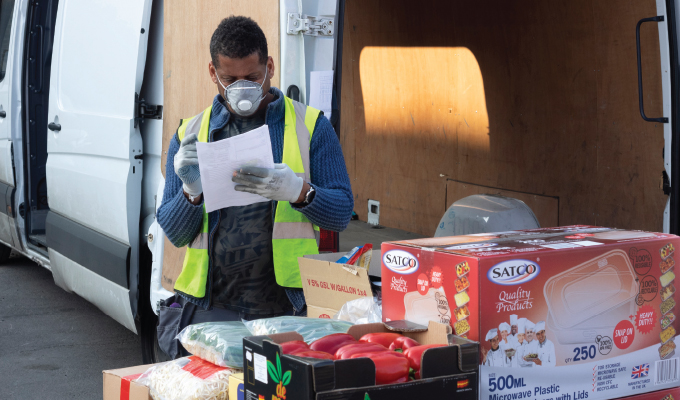As the world fights against COVID-19, we acknowledge the pivotal role played by industries providing essential products and services. They were important before, but these industries now work harder than ever and in challenging circumstances.
The US government put temporary measures in place to support industries with fleets, such as waiving certain CDL requirements. To view all measures visit fmcsa.dot.gov/covid-19. However, your company should also do its part to improve driver safety during this crisis. This will not only protect your company’s economic prosperity but the public at large.
Prior to the pandemic, fleets may have only looked at driver safety as avoiding crashes. However, driver safety should also now include your drivers’ physical health. A focus on both types of driver safety will reduce fleet risk and also provides greater societal benefits.
PROTECTING HEALTH
To know how to protect your drivers, you must know how COVID-19 is spread. According to the CDC, it’s spread from person-to-person and through contact with contaminated surfaces. There are measures that can be put in place to prevent the spread, including:
- Wash and sanitize hands frequently. Drivers must wash their hands for at least 20 seconds whenever there’s an opportunity. Provide drivers with hand sanitizer that contains at least 60% alcohol.
- Practice social distancing. If drivers deliver directly to customers, they must maintain a 6-ft distance. To further reduce contact, liaisons with drivers should be done using online tools.
- Use protective equipment. If you can procure face masks and gloves, provide these to drivers and train them on proper usage.
- Disinfect surfaces daily. This includes the inside and outside of vehicles including the steering wheel and door handles.
ON THE ROAD
Telematics technology provides a variety of tools to keep track of drivers’ movements, completed jobs, hours driven, and driving habits. Let’s look at how this monitoring can help driver safety.
If you’re in an industry delivering essential goods or services, you may have seen an uptick in activity. This means drivers are working longer hours or squeezing in more jobs to keep up with demand. This activity increase as well as the unusual circumstances will lead to stress and subsequent fatigue, an issue all fleets should keep an eye on.
Sleep deprivation can affect a person’s body in similar ways as drinking alcohol. For example, being awake for 18 hours straight makes you drive the same as someone with a blood alcohol level of .05 (The National Sleep Foundation, 2018). Driving tired leads to a decrease in concentration and slower reaction times, which increases the risk of a crash. Drivers become fatigued for many reasons including:
- Time of day. Drivers are more likely to fall asleep at the wheel from 2 am to 6 am and from 2 pm to 4 pm. A person’s body clock takes a natural dip during these times and causes drowsiness and reduced concentration (Horne, J., Reyner, L., 1995).
- Stress. Work-related stress has become more pronounced during the pandemic as people are worried about their and their loved ones’ health, job security, and much more.
- Driving long hours. Driving performance deteriorates after two hours of continuous driving, leading to slower reaction times and decreased concentration. The longer a person drives, the more rest they need (Lianzhen, W., Yulong, P., 2014).
YOUR PART
So what can you do as a fleet owner/manager to make the job safer? First, monitor driver behavior. Video telematics is one of the best tools for this as it gives an inside look into what’s happening in vehicles and on the road. When a driving event triggers a video recording, the clip can show if fatigue played a role.
Live streaming functions, now available with video telematics, can help monitor drivers in real time during the times when drivers are most likely to become fatigued (as discussed above). Should you see a driver nodding off, you can contact them via in-cab telematics tools to wake them up or ask them to pull over and rest.
Be aware of stress. Familiarize yourself with the symptoms and regularly check in with drivers. If you see stress manifesting, implement measures to counteract it. For example, if a driver says their workload is overwhelming, adjust their job schedule to allow more breathing room. Telematics technology offers job scheduling capabilities for this purpose.
Maintaining vehicle health through preventive maintenance and on-time repairs is also important for safety. On-board telematics keeps track of vehicle services and sends reminders of the next service date. This helps fleets schedule maintenance in advance and also check the mechanic’s precautions in preventing the spread of COVID-19.
On-board technology can also warn of engine-related issues, such as high oil pressure. Should any of these issues occur, the driver can be given live, in-cab feedback so immediate action can be taken to avoid engine damage.
By quickly heeding to engine-related warnings, you can prevent breakdowns. Fewer breakdowns equals less downtime, and downtime is something that cannot be afforded when essential products or services are needed.
FIRST PRIORITY
The above are all crucial ways to help your drivers stay safe during this pandemic. However, don’t become complacent once COVID-19 subsides and operations return to business as usual. Driver safety should always be a priority, no matter the circumstances.
FOR MORE INFORMATION
Find out more, visit www.mixtelematics.com.




